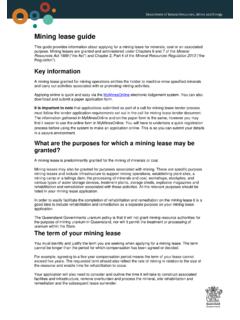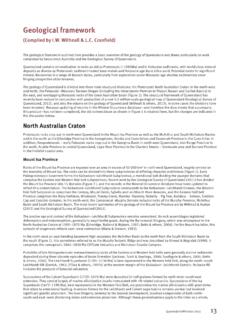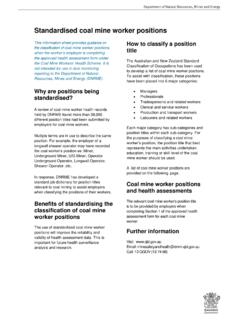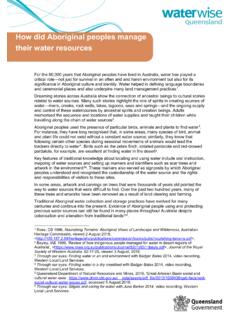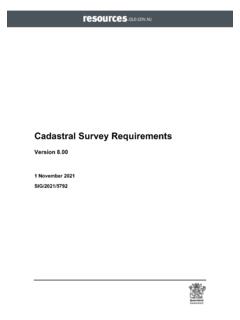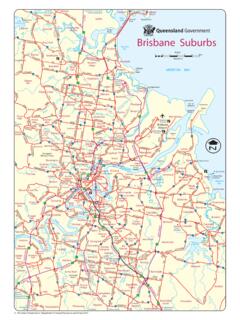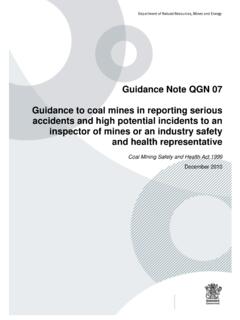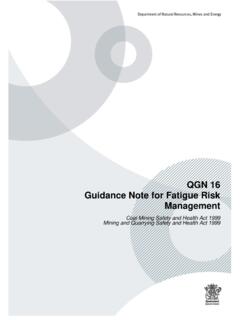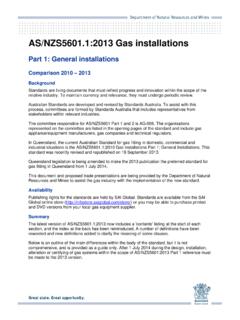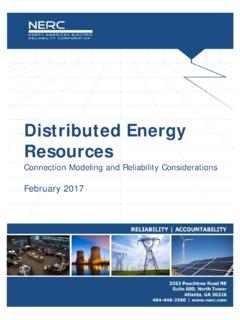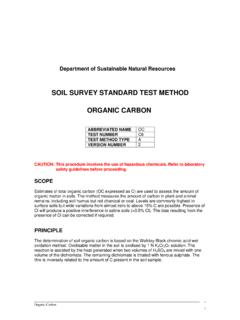Transcription of Recognised Standard 13 - resources.qld.gov.au
1 Recognised Standard 13 Tyre, wheel and rim management Coal Mining Safety and Health Act 1999 November 2016 This publication has been compiled by Department of Natural Resources, Mines and Water State of Queensland, 2015 The Queensland Government supports and encourages the dissemination and exchange of its information. The copyright in this publication is licensed under a Creative Commons Attribution Australia (CC BY) licence. Under this licence you are free, without having to seek our permission, to use this publication in accordance with the licence terms. You must keep intact the copyright notice and attribute the State of Queensland as the source of the publication. Note: Some content in this publication may have different licence terms as indicated. For more information on this licence, visit The information contained herein is subject to change without notice.
2 The Queensland Government shall not be liable for technical or other errors or omissions contained herein. The reader/user accepts all risks and responsibility for losses, damages, costs and other consequences resulting directly or indirectly from using this information. Recognised standards This document is issued in accordance with Part 5 Recognised standards and Section 37 (3) of the Coal Mining Safety and Health Act 1999. Part 5 Recognised standards 71 Purpose of Recognised standards A Standard may be made for safety and health (a Recognised Standard ) stating ways to achieve an acceptable level of risk to persons arising out of coal mining operations. 72 Recognised standards (1) The Minister may make Recognised standards. (2) The Minister must notify the making of a Recognised Standard by gazette notice. (3) The chief executive must keep a copy of each Recognised Standard and any document applied, adopted or incorporated by the Recognised Standard available for inspection, without charge, during normal business hours at each department office dealing with safety and health.
3 (4) The chief executive, on payment by a person of a reasonable fee decided by the chief executive, must give a copy of a Recognised Standard to the person. 73 Use of Recognised standards in proceedings A Recognised Standard is admissible in evidence in a proceeding if (a) the proceeding relates to a contravention of a safety and health obligation imposed on a person under part 3; and (b) it is claimed that the person contravened the obligation by failing to achieve an acceptable level of risk; and (c) the Recognised Standard is about achieving an acceptable level of risk. Part 3 Safety and health obligation 37. How obligation can be discharged if regulation or Recognised Standard made 37(3) .. if a Recognised Standard states a way or ways of achieving an acceptable level of risk, a person discharges the person s safety and health obligation in relation to the risk only by (a) adopting and following a stated way; or (b) adopting and following another way that achieves a level of risk that is equal to or better than the acceptable level.
4 Where a part of a Recognised Standard or other normative document referred to therein conflicts with the Coal Mining Safety and Health Act 1999 or the Coal Mining Safety and Health Regulation 2001, the Act or Regulation takes precedence. This Recognised Standard is issued under the authority of the Minister for Natural Resources and Mines. Recognised Standards may be updated from time-to-time. To ensure you have the latest versions, refer to the Department of Natural Resources and Mines website or contact your local Inspector of Mines: North Region PO Box 1752 Townsville Qld 4810 Ph (07) 4447 9248 Fax (07) 4447 9280 North Region PO Box 334 Mount Isa Qld 4825 Ph (07) 4747 2158 Fax (07) 4743 7165 South Region PO Box 1475 Coorparoo Qld 4151 Ph (07) 3330 4272 Fax (07) 3405 5345 Central Region PO Box 3679 Red Hill Rockhampton Qld 4700 Ph (07) 4936 0185 Fax (07) 4936 4805 Central Region PO Box 1801 Mackay Qld 4740 Ph (07) 4999 8512 Fax (07) 4999 8519 Recognised Standard Tyre, wheel and rim management, Department of Natural Resources and Mines, 2016 iii Table of contents Recognised iii 1.
5 Purpose .. 1 2. Scope .. 1 3. Application framework .. 1 Wheels and rims .. 1 Tyres .. 1 Associated tools and equipment .. 1 Exclusions .. 1 4. Technical guidance .. 2 Tyre, wheel and rim selection and procurement .. 2 Receipt and storage of tyres and rims .. 5 Mounting, demounting, assemble and disassemble .. 8 Tyre maintenance facility .. 12 Maintenance and upkeep of tyres, wheels and 14 Operation and hazardous conditions management .. 16 Removal and disposal of tyres, wheels and rims .. 19 Systems review .. 22 5 Definitions .. 23 6 References .. 25 7 Appendices .. 26 Appendix 1 Risk assessment outline .. 26 Appendix 2 Coroner s recommendations .. 27 Recognised Standard Tyre, wheel and rim management, Department of Natural Resources and Mines, 2016 iv 1. Purpose The purpose of this Standard is to give an outline of what elements must be considered in a mine s Safety and Health Management System (SHMS) and to assist in the development of a Standard Operating Procedure, and other procedures, for the management of tyres, wheels and rims at a coal mine.
6 It provides a managed approach to achieve an acceptable level of risk to persons using the SOP required by Section 72 (a) of the Coal Mining Safety and Health Regulation 2001. 72 Miscellaneous A coal mine must have Standard operating procedures for the following (a) fitting, removing, testing, maintaining and repairing tyres and rims on fixed and mobile plant; 2. Scope This Standard applies to all tyres, wheels and rims on mobile, transportable and fixed plant at a mine and includes all associated tools and equipment as mentioned in this Standard . 3. Application framework Wheels and rims There are many designs of wheels and rims in use at mines - single piece wheels, industrial two piece and multi piece wheels and rims. Tyres There many types of tyres in use at a mine, pneumatic tyres (radial and bias construction), filled tyres (polyurethane, rubber insert and water ballasted) and solid tyres.
7 Associated tools and equipment Equipment mentioned in this Standard that is used for fitting, removing and handling of tyres, wheels and rims, for example tyre handler, forklift etc. Exclusions Tyres, wheels and rims that have a proven low risk (such as tyres and wheels or rims fitted to gas trolleys, wheelbarrows, parts trolleys, ride on lawnmowers, and earthmover equipment jacks) are excluded from this Standard . Also tyres, wheels and rims that the mine risk assessment identifies as low risk may be excluded from this Standard . The controls for all excluded items are to be contained in the mine s SHMS; this Standard may be used as guidance material in developing the controls. Note: Recognised standards are not mandatory Recognised standards are not mandatory, but when followed provide a way of meeting safety and health obligations. A person may adopt another way of managing that risk, however in the event of an incident the person may be required to show that the method adopted was equivalent to the method in the Recognised Standard .
8 Note: Risks associated with overpressure, split wheels and plastic wheels fitted to plant such as wheel barrows or trolleys must be considered. Recognised Standard Tyre, wheel and rim management, Department of Natural Resources and Mines, 2016 1 4. Technical guidance The controls mentioned in this Standard will form part of the mine s SHMS and may be an integral part of the Standard Operating Procedure. The system is to have regard for the guidance given in this section that covers the life cycle of tyres, wheels and rims from procurement to disposal. Major hazards associated with tyres and wheel or rim components include their physical size, weight, complexity of multi-piece wheels and rims, stored pressure energy, potential for explosion and the damage resulting from the arduous conditions to which they are subjected. Manual handling is possible for only a few types of tyre, wheel or rim as most are of a size and weight that necessitates machine assistance.
9 Trained personnel are required for work on the wheel and rim assemblies due to the complexity and critical nature of the work. The consequences of rapid deflation, tyre fire and ejection of wheel or rim components have resulted in fatal accidents and serious injuries to mine workers. Sound tyre and rim management = safe production Tyre and rim - selection and Receipt and storage of tyres and Mounting, demounting, assemble and Fit for purpose tyre maintenance facility Maintenance and Operation and hazardous conditions Removal and Information documentation and tracking Systems Tyre, wheel and rim selection and procurement The first element in development of a tyre, wheel and rim management system is selection and procurement of the tyre and wheel or rim. The systematic risk assessment approach requires that the correct people are involved, for instance the tyre, wheel and rim manufacturers, mine designers and operators, tyre, wheel and rim technicians and maintainers and the plant OEM.
10 Data required for the risk assessment is to include: Application: o Earthmoving, large tyres, wheel or rims, light vehicle or fixed plant o Will the wheel or rim be a multi-piece, divided (two piece or split rim), single piece or drop centre? o Will the mounting be cleat mounted or disc mounted? o Will the tyre be for earthmoving, grader, truck, light vehicle or fixed plant? Will it have lugs, tread or smooth? o Is the tyre pneumatic or is there a requirement for solid fill or solid tyres? Solid or solid fill are generally used for slow moving or occasionally moved equipment (trailers, crib huts). Recognised Standard Tyre, wheel and rim management, Department of Natural Resources and Mines, 2016 2 o What is the TKPH (earthmoving) or duty cycle required? o What are the conditions of operation, type of plant, payload, speed, environment conditions, equipment utilisation, road gradients and road surfaces?
